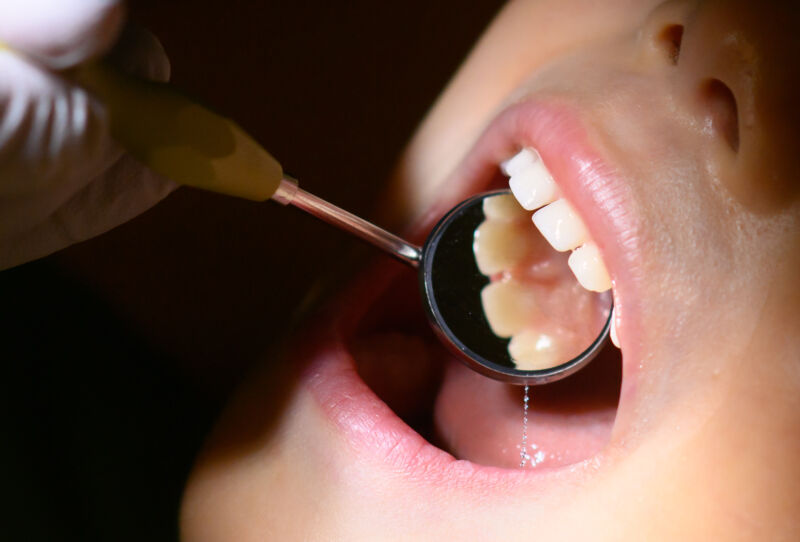
The field of dentistry is lagging on adopting evidence-based care and, as such, is rife with overdiagnoses and overtreatments that may align more with the economic pressures of keeping a dental practice afloat than what care patients actually need. At least, that’s according to a trio of health and dental researchers from Brazil and the United Kingdom, led by epidemiologist and dentist Paulo Nadanovsky, of the University of the State of Rio de Janeiro.
In a viewpoint published Monday in JAMA Internal Medicine, the researchers point out that many common—nearly unquestioned—practices in dentistry aren’t backed up by solid data. That includes the typical recommendation that everyone should get a dental check-up every 6 months. The researchers note that two large clinical trials failed to find a benefit of 6-month check-ups compared with longer intervals that were up to 2 years.
A 2020 Cochrane review that assessed the two clinical trials concluded that “whether adults see their dentist for a check‐up every six months or at personalized intervals based on their dentist’s assessment of their risk of dental disease does not affect tooth decay, gum disease, or quality of life. Longer intervals (up to 24 months) between check‐ups may not negatively affect these outcomes.” The Cochrane reviewers reported that they were “confident” of little to no difference between 6-month and risk-based check-ups and were “moderately confident” that going up to 24-month checkups would make little to no difference either.
Likewise, Nadanovsky and his colleagues highlight that there is no evidence supporting the benefit of common scaling and polishing treatments for adults if they don’t have periodontitis. And for children, cavities in baby teeth are routinely filled, despite evidence from a randomized controlled trial that rates of pain and infections are similar—about 40 percent—whether the cavities are filled or not.
As for the disconnect between common practices and the state of the evidence, the researchers suggest that economic pressures are largely to blame, as well as the training and opinions of practicing dentists and the expectations of patients—”all of which tend to favor excessive diagnoses and interventions,” the researchers write. The problem may date back to the 1970s and 1980s, when fluoridated toothpastes became common and the rate of cavities saw an “extraordinary decline.” That left dentists with a financial need to find new ways to keep their offices filled, even if teeth didn’t need to be.
And this created two problems: People being overtreated or not treated at all, the researchers wrote.
The prevailing dental economic model based on fee-for-service creates an environment of dental overdiagnosis and overtreatment. At the same time, many persons who do not have dental insurance cannot afford to pay out of pocket for dental care, creating a situation where people with low income or who are part of a racial and ethnic minority group are often underdiagnosed and undertreated.
The researchers called for more clinical trials to assess the effectiveness and benefits of treatments and to have dental guidelines updated accordingly. Then, Nadanovsky and colleagues said, resources can be allocated to the patients who need them the most. “The aim is to reduce overdiagnosis and overtreatment while increasing necessary treatment,” they conclude.
In a lengthy statement to Ars, the American Dental Association responded to the viewpoint saying that it is “dedicated to evidence-based dentistry.” The ADA defined evidence-based dentistry as that which “integrates the dentist’s clinical expertise, the patient’s needs and preferences, and the most current, clinically relevant data. All three are part of the decision-making process for patient care.”
The ADA did not respond directly to questions regarding the shaky evidence behind common practices and recommendations, such as 6-month check-ups. (The ADA does not recommend a specific interval between visits, but recommends seeing a dentist “regularly“.) Instead, the ADA emphasized that the “dentist-patient relationship is critically important.” While noting the “ethical responsibility of dentists,” the ADA focused on the role of patients in their care. According to the ADA, patients should be selective in finding a dentist, receive dental care cost estimates up front, and always ask questions and discuss alternatives. The association also referenced its statement on dental patient rights and responsibilities.
“Patients always have the option to discuss alternative treatment plans, decline care, or seek another opinion,” the ADA told Ars.
“The nation’s dentists have long sought to turn the tide of untreated oral disease and advise people to visit their dentist regularly for recommendations specific to their individual needs developed in accordance with the latest scientific evidence available,” the ADA said.




















+ There are no comments
Add yours